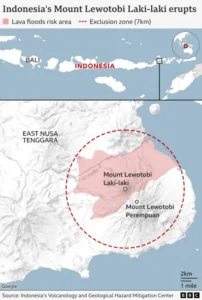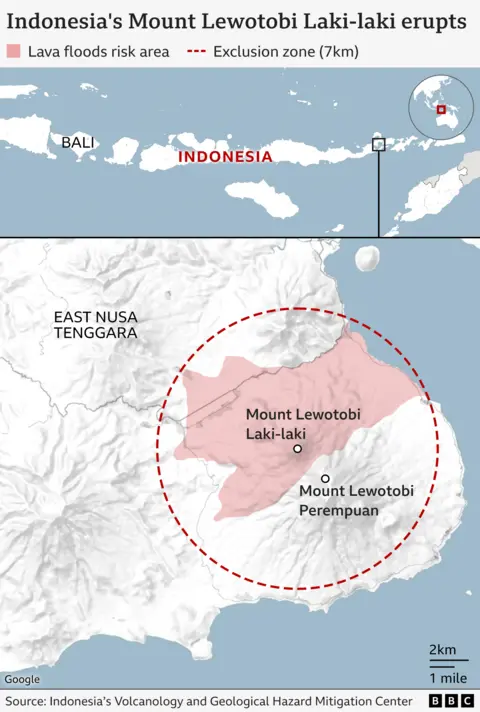**Indonesian Volcano Eruption: A New Threat from Mount Lewotobi Laki-laki**
Indonesia’s Mount Lewotobi Laki-laki has erupted yet again, sending an enormous ash cloud soaring into the atmosphere, reaching heights of approximately 18 kilometers (about 11 miles). This alarming event has caused local residents to evacuate their homes as they face the dangers presented by volcanic activity. The eruption series, which began early on a Monday morning, marks the latest instance in a series of eruptions that have plagued this particular volcano over the past few months, with authorities maintaining a strict level of caution since the alert was raised to the highest tier due to earlier eruptions three weeks prior.
As of the latest reports, there have been no casualties directly attributed to the recent eruption. However, the local infrastructure has been severely disrupted, leading to the cancellation of at least 24 flights to and from Bali, a major tourist destination nearby. While service resumed the following day, the Governor of Flores has urged both caution and preparedness among the locals.
Geology agency head Muhammad Wafid pointed out that the initial volcanic eruption, occurring at 11:05 AM local time, produced the most significant eruption observed since November of the previous year. Such a powerful demonstration of geological activity raises concerns regarding its implications for aviation safety, as Wafid noted the heightened level of threat associated with the plume of ash.
The ensuing disturbances caused authorities to enlarge the exclusion zone around the volcano to a radius of 7 kilometers from the central vent, a precautionary measure aimed at safeguarding the surrounding communities. Furthermore, experts are alert to the risk of lahar floods, which occur when heavy rains mix with volcanic ash and debris, resulting in fast-moving mud flows.
Later eruptions occurred late in the evening and early the next morning, producing ash clouds that ascended to approximately 13 kilometers. Residents have been seen fleeing the area in droves, with video evidence showcasing the fiery lava spouting from the volcano’s peaks as they sought refuge.
According to reports from the local disaster management agency, over 4,000 individuals have been evacuated from the vicinity of Mount Lewotobi Laki-laki. The evacuation has led to a dire situation for those who have chosen to stay behind, facing critical shortages of food, clean water, and respiratory masks against the ash fallout.
Paulus Sony Sang Tukan, the village head of Pululera located about 8 kilometers from the active volcano, emphasized the challenges that remaining residents face. He pointed out that while water could still be sourced, there were concerns regarding its contamination due to the thick layer of volcanic ash blanketing the region following the eruptions.
The geological characteristics of Indonesia, sitting atop the Pacific “Ring of Fire,” result from the convergence of tectonic plates, thus making the region highly susceptible to frequent volcanic eruptions and earthquake activity. Mount Lewotobi Laki-laki’s recent eruptions are not isolated incidents, with this volcano showing activity multiple times within the current year. Fortunately, no casualties have been reported from these recent instances, which stand in contrast to the tragic events of November when prior eruptions claimed the lives of ten individuals and necessitated the evacuation of thousands.
Interestingly, Mount Lewotobi Laki-laki pairs with its counterpart Mount Perempuan, which translates to “woman” in Indonesian. This duality is emblematic of both the geographical and cultural significance embedded in Indonesian heritage.
For those following the developments of this volcanic crisis, additional coverage includes insights provided by local journalists, such as Eliazar Ballo reporting from Kupang, who continue to monitor the situation closely as it unfolds.
The people in the affected areas are urged to stay updated as scientists and authorities work to ensure the safety of the public while grappling with the unpredictable nature of volcanic eruptions in this seismically active region.










